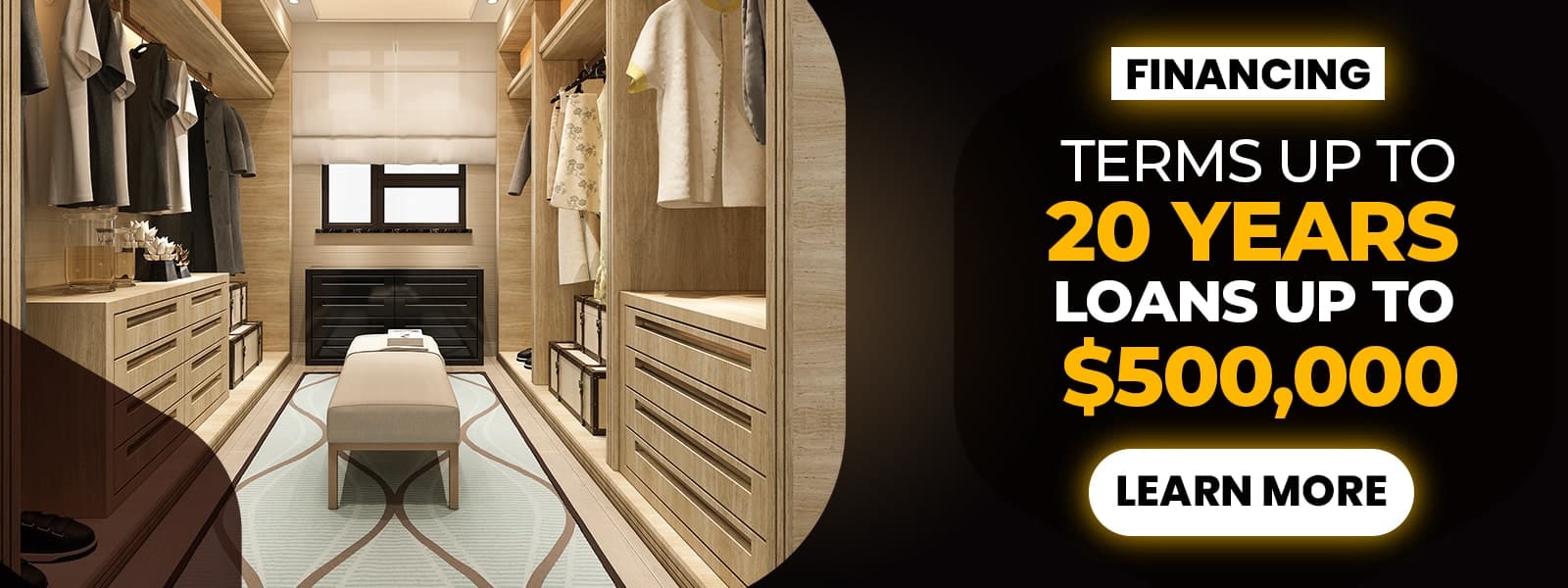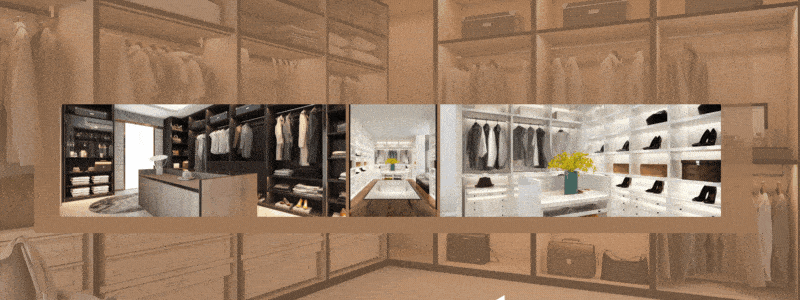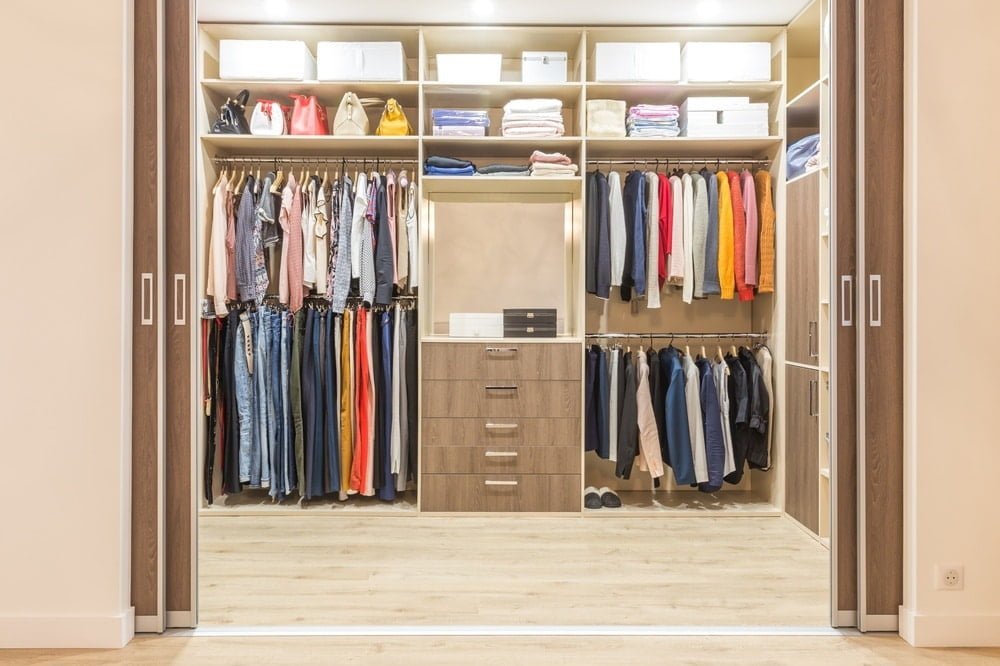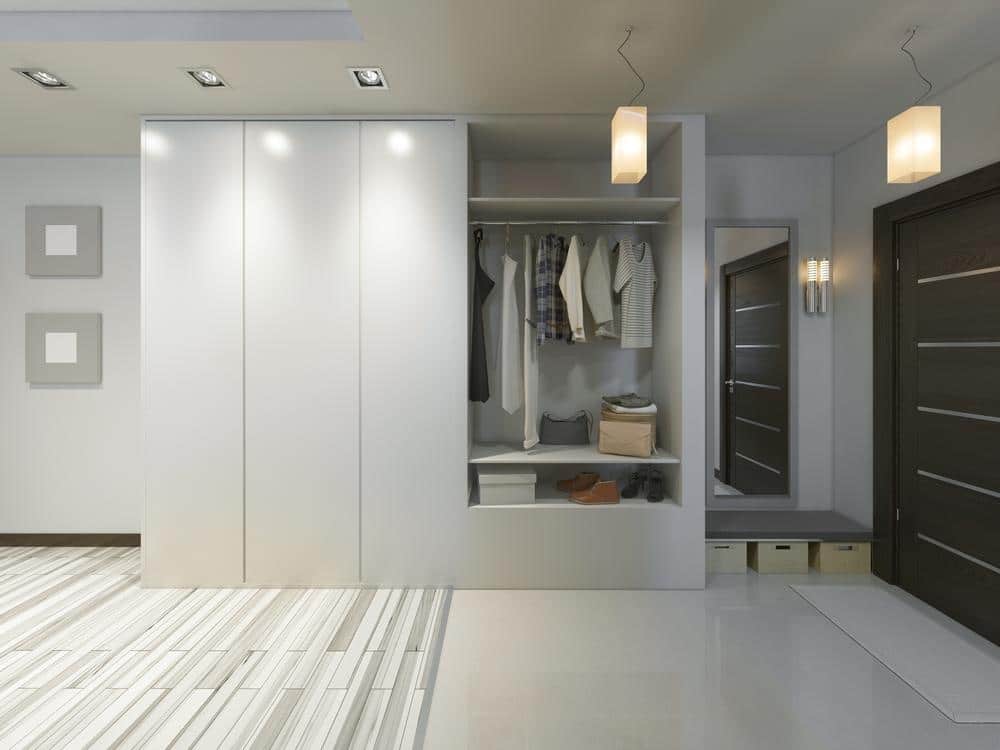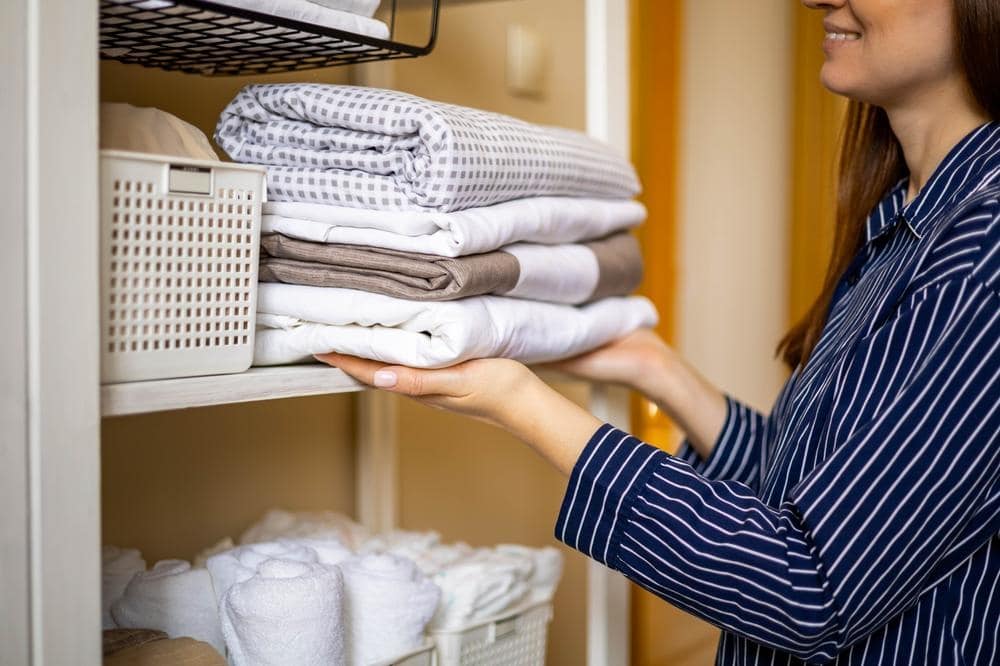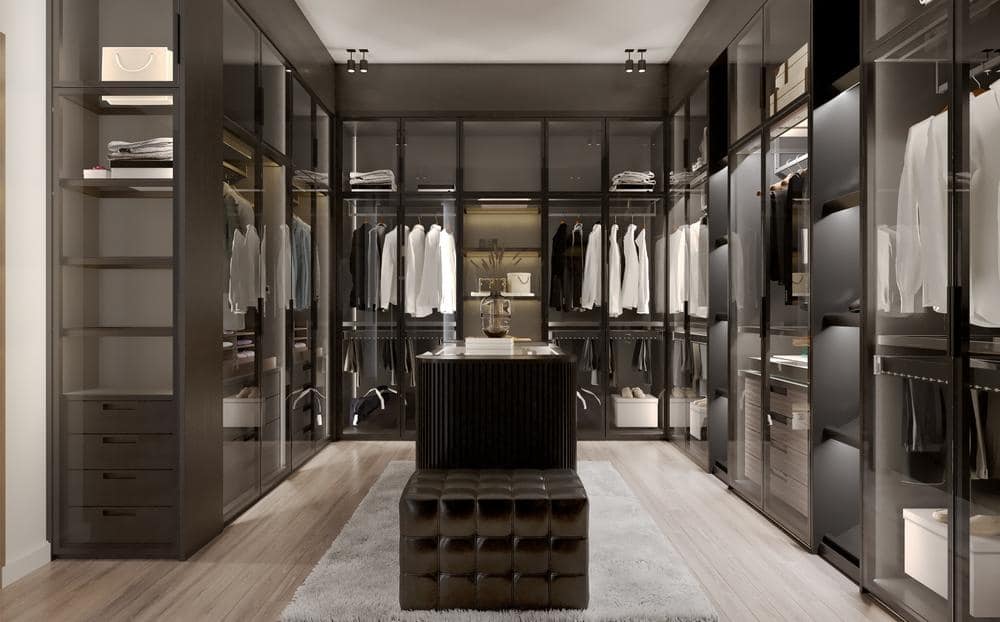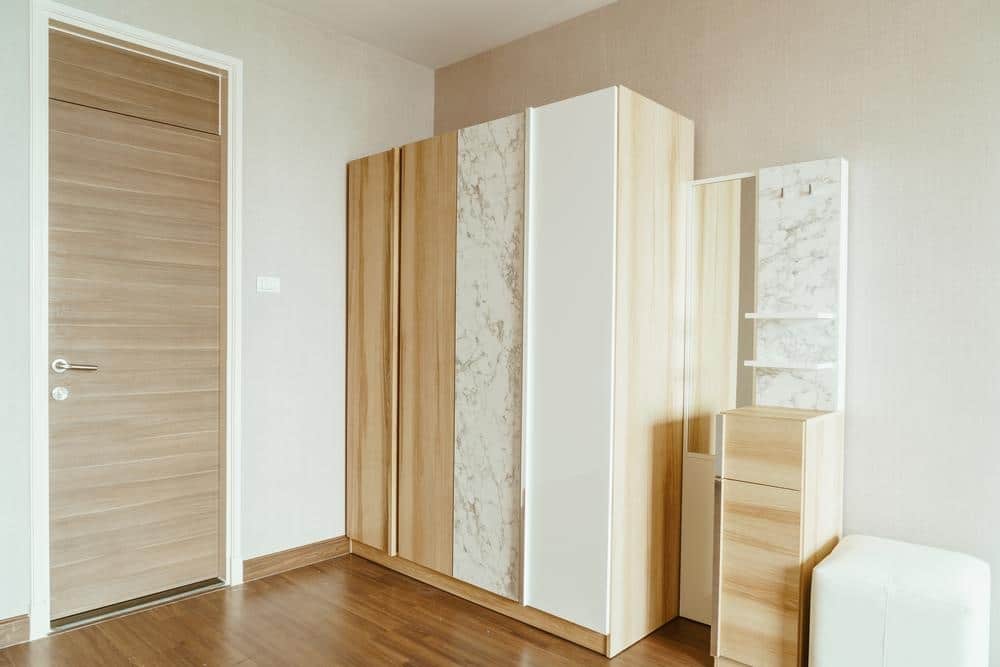Don’t let your mudroom feel like an afterthought! Transform your entryway into a stylish, functional space with these 27 inspiring mudroom ideas. Whether you have a small space or a limited budget, we’ll help you find the perfect way to incorporate trendy wall space, floor tiles, and wall hooks into a beautiful exterior design. Read on to create your mudroom of dreams.

Why Invest in Designing a Mudroom
Table of Contents
- Why Invest in Designing a Mudroom
- Make Space with a Shiftsand Mudroom
- Make Use of Wall Space with Wall Hooks
- Mudroom Built In Ideas
- Make Use of Floor Space
- Create Dedicated Mudroom Storage
- Incorporate Stylish Patterned Floor Tiles
- Make Use of Mudroom Cabinets
- Incorporate a Mudroom Bench
- Incorporate a Drop Zone
- Include Functional Mudroom Accessories
- Make Use of Floor to Ceiling Cabinets
- Create a De Facto Mudroom
- Incorporate a Coat Rack
- Introduce Meaningful Interior Design
- Utilize Wicker Baskets
- Utilize a Statement Light Fixture
- Hang Up Artwork
- Utilize Graphic Wallpaper
- Use Outdoor Accessories
- Choose Durable Flooring
- Incorporate a Simple Wooden Bench
- Utilize a Small Bench
- Create a Catchall Space
- Use Built-in Cabinets
- Include a Partial Wall
- Create a Mini Mudroom
- Utilize a Double Duty Design
- Makeshift Mudroom Designed
- Coat Closet Mudroom
- Small Mudroom Ideas
- Entryway Mudroom Ideas
- Laundry Mudroom Ideas
- Modern Mudroom Ideas
- Garage Mudroom Ideas
- Farmhouse Mudroom Ideas
- Front Entrance Mudroom Ideas
- Mudroom Laundry Room Ideas
- Mudroom Storage Ideas
- Mudroom Decor Ideas
- Mudroom Design Ideas
- Mudroom Ideas With Bench
- Mudroom Organization Ideas
- Mudroom Wall Ideas
- Mudroom Cabinet Ideas
- Mudroom Decorating Ideas
- Mudroom Flooring Ideas
- Mudroom Tile Ideas
- Rustic Mudroom Ideas
- Narrow Mudroom Ideas
- Hallway Mudroom Ideas
- Simple Mudroom Ideas
- Tiny Mudroom Ideas
- Mudroom Lighting Ideas
- What Should A Mudroom Include?
- How Do You Make A Mud Room Look Nice?
- Are Mudrooms Worth It?
- How Do You Style A Small Mudroom?
- What Is The Best Floor For A Mudroom?
- How Much Value Does A Mudroom Add?
- How To Design A Mudroom?
- What Is The Standard Size Of Mudroom?
- How Do You Make A Mudroom FunctIonal?
- What Is The Purpose Of A Mudroom?
- Is A Drop Zone The Same As A Mudroom?
- What’s The Difference Between A VestIbule And A Mudroom?
- How Do You Maximize Storage In A Mudroom?
- What’s The Difference Between A Foyer And Mudroom?
- Why Are Mudrooms Disappearing?
- How Much Does A Custom Mudroom Cost?
- Where Should A Mudroom Be Located?
- What Color Is Good For A Mudroom?
- What Color Should Mudroom Be?
- Can Mudroom Be In Entryway?
- What Do If You Have No Mudroom?
- Is Mudroom the Same As Laundry Room?
- Is a mud room worth it?
- How much value does a mudroom add to a house?
- Are mudrooms still popular?
- Does adding a mud room add value?
- Should a mudroom have a sink?
- Do mud rooms have doors?
- When did mudrooms become popular?
- How do you make a perfect mudroom?
- How do you dress up a mudroom?
- Does a mudroom add value?
- How do I maximize my mudroom?

A mudroom is a great way to add a gracious introduction to your home and make a lasting first impression. When designed aesthetically and efficiently with well-thought-out decor and storage solutions, a mudroom can make a big difference in the overall vibe of your home. This dedicated space provides a place to store shoes, capes, and other necessary items. Moreover, having a designated space for your essentials can avoid clutter in other parts of the home.
Make Space with a Shiftsand Mudroom
If you need more space or budget to work with, you can create a makeshift mudroom. To do this, simply designate an area in your home, such as by the entrance, that functions as a mudroom. Utilize wall space and floor space to add hooks, cabinets, and cubbies that keep coats, umbrellas, hats, and other necessary items organized and off the floor. You can also utilize furniture such as benches or stools to make the space more inviting.
Make Use of Wall Space with Wall Hooks
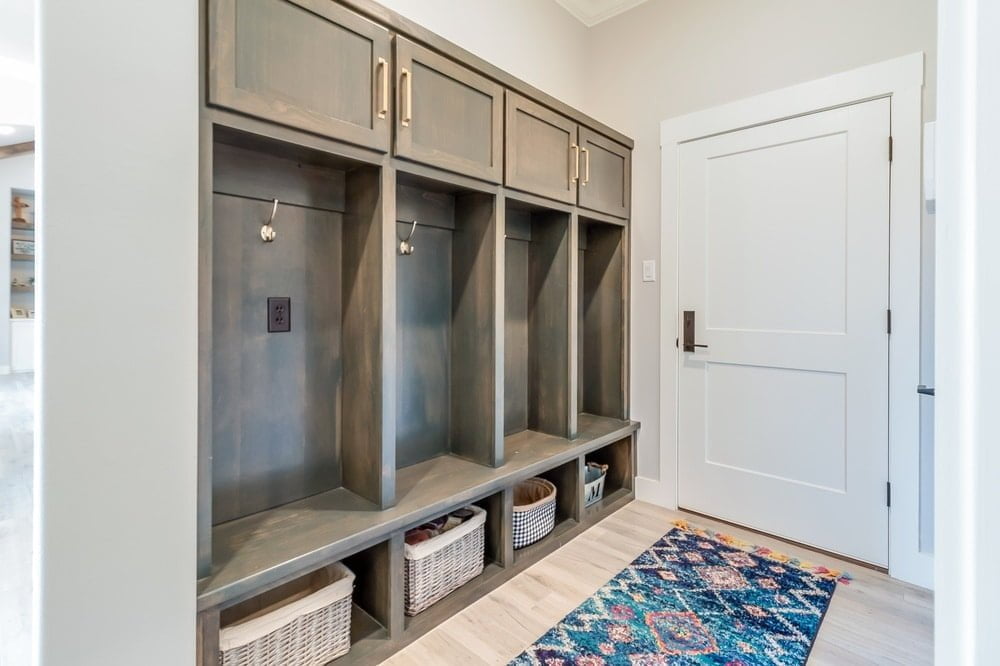
Wall hooks are perfect for keeping coats and hats out of the way in a mudroom. Group several wall hooks together in threes or four or evenly spaced out. If you’re working with a larger space, add more. You may also choose decorative wall hooks that match the rest of your mudroom décor.
Mudroom Built In Ideas
Consider adding a built-in mudroom to your home if you have the space. This is especially helpful if you need storage solutions. With custom cabinetry, drawers, shelves, and more, you can design a mudroom that fits in with the rest of the home’s décor. This is especially helpful if you need storage solutions.
Make Use of Floor Space

Utilizing your floorspace can create a functional and practical space. When designing a mudroom, you can make use of available floor space. Depending on the size and shape of your mudroom, a rug can tie the area together and be easily swapped in and out. Alternatively, consider decorative patterned floor tiles, which may provide the same effect. Finally, you will want to consider storage solutions for the floor. Such solutions may include benches, bins, and baskets for shoes and other items, allowing you to keep all of your essentials organized and where you can easily access them.
Create Dedicated Mudroom Storage
One critical aspect of designing a mudroom is dedicated mudroom storage. Dedicated storage can help the mudroom look cohesive and organized, making it easier to keep the area tidy. Consider installing floor-to-ceiling cabinets, cubbies, shelves, and hanging racks to create a space where you can store and organize your essentials. This is especially helpful if you don’t have a lot of wall space or floor space to work with.
Incorporate Stylish Patterned Floor Tiles
One of the best ways to add personality to a mudroom is to incorporate patterned floor tiles. This is an easy way to make the mudroom feel modern and stylish and help protect the floors from dirt, moisture, and other elements. Patterned floor tiles come in all styles and are highly durable, making them perfect for a space that is likely to see a lot of foot traffic.
Make Use of Mudroom Cabinets

Mudroom cabinets are a great storage solution and help keep items off the floor and clutter-free. You can find cabinets in various shapes and sizes, colors, materials, and designs. This can be a great way to add a functional yet stylish element to your mudroom. Furthermore, cabinets can also be used to hide necessities such as a washer and dryer and can still be used to store items such as extra blankets and pillows.
Incorporate a Mudroom Bench

A mudroom bench can be an attractive feature in any entryway. Whether your bench is hefty and sturdy or small and simple, the bench is the perfect place to sit down and lace up your shoes or take off your coat. Moreover, benches are convenient if you want a place to put on and take off your shoes or keep delicate items off the floor. If space allows, a bench is an ideal option for a mudroom.
Incorporate a Drop Zone
A drop zone is one of the best ways to make your mudroom functional and organized. Drop zones are great for organizing smaller items and adding an inviting element to a mudroom. Adding a drop zone means keeping items like keys, coupons, and mail off the counter, away from spills, and easily finding them when needed. Furthermore, you can create a drop zone with a few wall hooks if you have little space.
Include Functional Mudroom Accessories
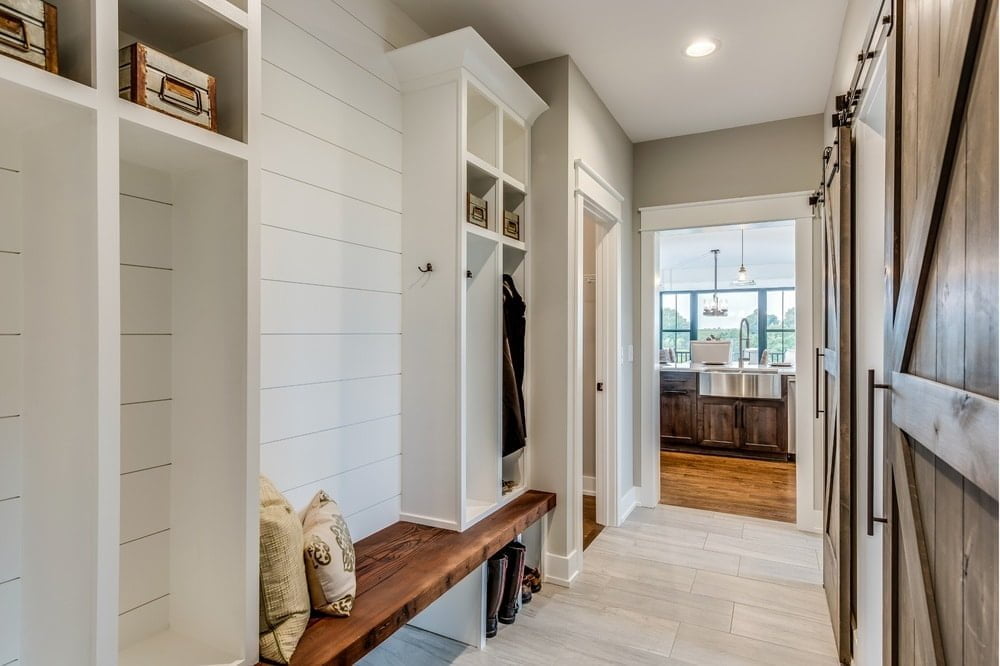
Various accessories can help make your mudroom as valuable and stylish as possible. You should include a few functional accessories to maximize the space if you have a dedicated mudroom. For example, you can add wicker baskets to store various items such as shoes, hats, and towels. You may also add dedicated storage for outdoor accessories or a statement light fixture to make the space more inviting.
Make Use of Floor to Ceiling Cabinets
If you have room in your mudroom, floor-to-ceiling cabinets can help you conveniently store items. Such cabinets are great for organizing items like books, toys, and toiletries. Furthermore, You can also use them to store other items such as coats, hats, and gloves. Floor-to-ceiling cabinets are perfect for a mudroom, providing both style and function.
Create a De Facto Mudroom
A de facto mudroom is a creative way to turn any small space into a mudroom. Whether it’s a coat closet, a corner of the entryway, or even a tiny space in the kitchen, you can turn any space into a mudroom with a few key storage elements. Consider adding a small bench, wicker basket, and coat rack to create a dedicated area for storing shoes, coats, hats, and other items—this is a great way to use small spaces and add a functional, practical element to your home.
Incorporate a Coat Rack
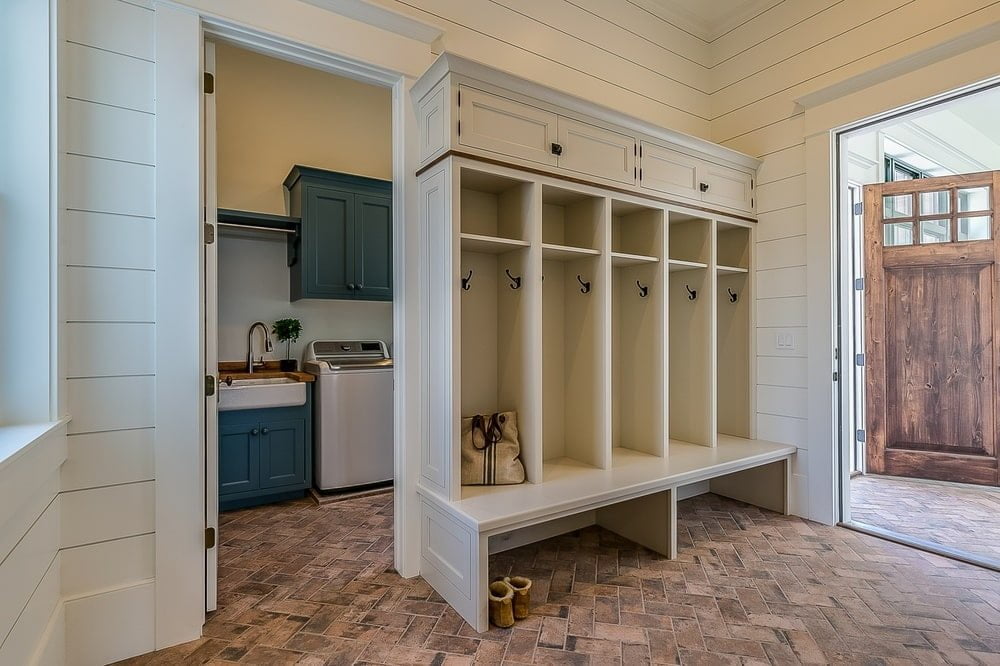
If you don’t have enough wall space for a coat closet or floor space for a storage bench, a coat rack is one of the most straightforward solutions for storing coats and hats. Coat racks are perfect for keeping your items off to the side and can be easily installed in a small space, such as the corner of the entryway. They are also perfect for storing other items, such as scarves, handbags, and umbrellas. Furthermore, coat racks come in all sorts of designs, making it easy to find one that fits your mudroom décor.
Introduce Meaningful Interior Design
You don’t need to break the bank on interior design for your mudroom. Incorporating meaningful interior design features, such as graphic wallpaper and artwork, can help make the space more inviting and create an aesthetic that reflects your personality. Utilizing bold, eye-catching accents and décor can help elevate the look of your mudroom and make it feel more welcoming.
Utilize Wicker Baskets

Wicker baskets are a great way to keep items off the floor and out of sight. If you don’t have enough wall or floor space, you can use wicker baskets to store items such as shoes, hats, and towels. You can also use wicker baskets to store items such as books, toys, and miscellaneous items. They can help to make your mudroom look organized, tidy, and stylish.
Utilize a Statement Light Fixture
Adding a statement light fixture to your mudroom can help bring the area to life and make it incredibly inviting. Whether a chandelier, pendant, or wall sconce, a light fixture can draw attention to the area and add an elegant touch. Additionally, a light fixture can help make the space look bigger and brighter.
Hang Up Artwork
Artwork is a great way to add a unique touch to your mudroom. Whether it is a statement piece or something that reflects your personality, hanging up artwork can make the space feel more personal and lived in. Furthermore, it can provide the perfect finishing touch to your mudroom and make it more inviting.
Utilize Graphic Wallpaper
Graphic wallpaper can be fun to add some interest to your mudroom and make it stand out. Graphic wallpaper is perfect for accentuating the walls of a small space, making the room look more inviting and vibrant. Consider a bold pattern or bright color to create an eye-catching feature and tie the entire area together.
Use Outdoor Accessories
Outdoor accessories are a great way to create a functional and stylish mudroom. You can utilize benches, storage bins, and shelving to help keep items organized and out of the way. You can also use outdoor accessories to add fun and playful elements to the space. Consider adding wicker baskets, patterned rugs, or statement lamps to brighten the area.
Choose Durable Flooring
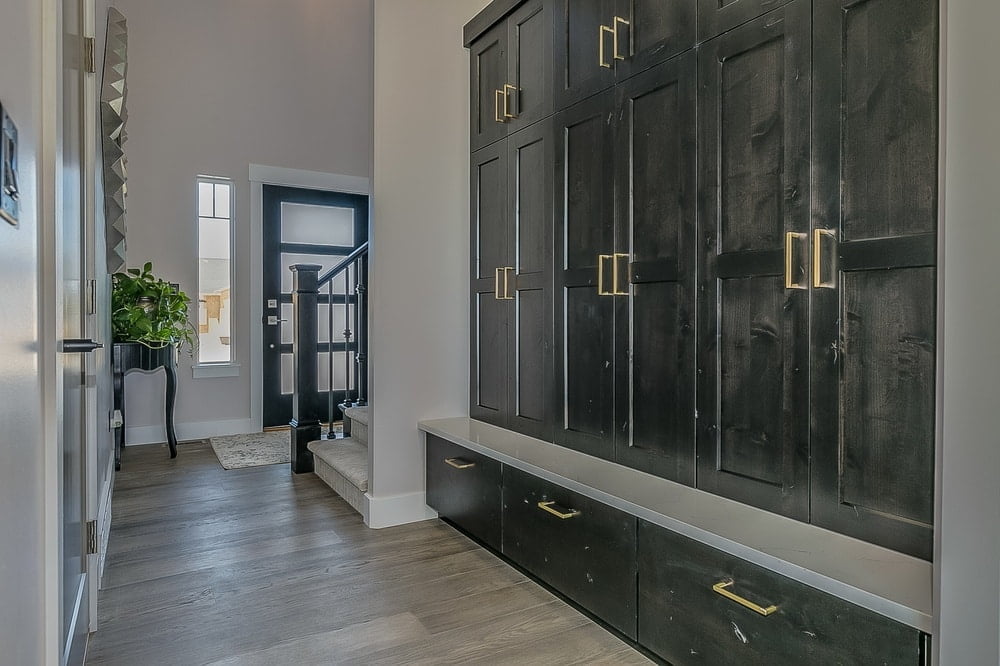
When choosing to floor for your mudroom, durability is an essential factor. Choose flooring that is waterproof and can withstand heavy foot traffic. Flooring options such as tile and laminate are excellent choices for a mudroom, as they are both durable and stylish. They are also easy to clean, making them perfect for spaces that are likely to get Dirty.
Incorporate a Simple Wooden Bench
A simple wooden bench can make a big difference in the overall look of a mudroom. Add a classic wooden bench to the area to create an inviting sitting area and provide a functional element. A bench can easily be dressed with pillows and other accessories, making it a stylish and comfortable addition to your mudroom.
Utilize a Small Bench
A small bench is a perfect option for your mudroom if you’re working with a small space. Small benches are great for storing and organizing items without taking up too much space. Furthermore, they are also incredibly versatile and can be used for various purposes. For example, a small bench could be used as an extra seating area or for storage.
Create a Catchall Space
A catchall space is a great way to keep smaller items close at hand and out of sight. Utilizing bins, baskets, and drawers, you can create a catchall space that provides a place to store items such as keys, coupons, and mail. This is great for de-cluttering small spaces and making the entryway look organized and neat.
Use Built-in Cabinets
Built-in cabinets are a great way to maximize floor space and provide storage for items such as coats, hats, towels, and shoes. They can easily be installed in the corner of a mudroom and provide plenty of storage for keeping items organized and out of the way. Furthermore, built-in cabinets are also great for hiding items such as a washer and dryer, making them incredibly functional.
Include a Partial Wall
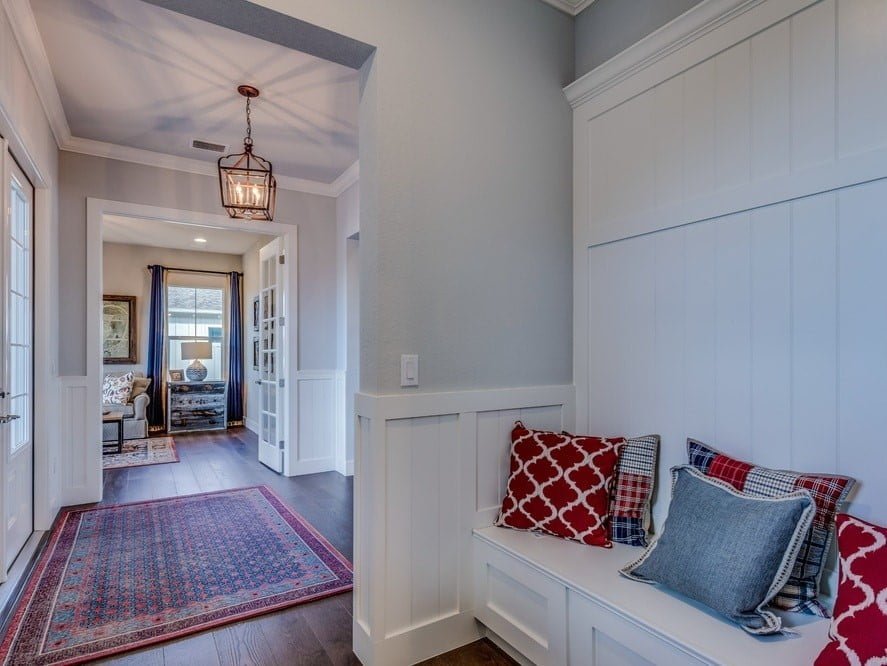
Consider adding a partial wall to your mudroom to keep the area more enclosed and to provide a space for hanging items such as coats and hats. Partial walls also create a sense of privacy and help create separation between the room and the rest of the home. Additionally, You can easily decorate partial walls with artwork or functional items such as coat racks and shelving units.
Create a Mini Mudroom
For those with a limited area to work with, creating a mini mudroom is a great way to make the most of a small space. You can easily incorporate a mini mudroom by utilizing shelves and bins and adding a small bench or chair. This will provide a designated area for storing items such as shoes, hats, and coats and will also help keep the area looking tidy and organized.
Utilize a Double Duty Design
A double-duty design is an excellent way to make the most of a small space. Consider incorporating furniture or storage solutions such as benches with hidden storage or shelves with drawers. This way, you can serve both form and function, making the most of the space while also making the area look more organized and stylish. A double-duty design can also make the mudroom feel more inviting and cozy.
Makeshift Mudroom Designed
Creating a makeshift mudroom doesn’t have to be complicated or expensive. Consider using a shelving unit with cubbies, baskets, and bins to store items such as shoes, hats, towels, and coats. You can also add hooks on the wall for hanging lightweight items. This makeshift mudroom is perfect for apartments or smaller homes that don’t have dedicated mudroom space.
If you want to maximize the storage potential of your makeshift mudroom, consider incorporating mudroom cubbies. These are great for organizing items and keeping them off the floor. You can keep items such as shoes, hats, and coats organized and out of sight with mudroom cubbies. Cubbies come in various sizes and styles, so you can easily find ones that fit your needs and style.
Coat Closet Mudroom

Consider utilizing your home’s entryway as a coat closet mudroom if you have a large family or live in a high-traffic area. This mudroom type is perfect for large families and can easily accommodate multiple coats, hats, and other items. You can install wall hooks to hang items such as jackets, scarves, and purses. You can also add shelves and drawers to store items such as hats, gloves, and shoes.
Furthermore, you can also add a large bench for extra seating or shoe storage. With these ideas, you can easily create a coat closet mudroom that is both functional and stylish.
Small Mudroom Ideas
If you have a small area to work with, don’t worry! There are plenty of ways to make the most out of the space. Consider utilizing shelves and bins for storing items such as shoes, hats, and coats. You can also add hooks on the walls or doors for hanging lightweight items. Additionally, benches are perfect for providing seating and extra storage. With these small mudroom ideas, you can easily create a cozy, inviting, functional, and organized space.
Whether you have a large or small area to work with, there are plenty of ways to make the most of the space. You can easily create an inviting and organized mudroom with some creativity and clever design ideas. Using the tips above, you can easily create a stylish and functional mudroom.
Entryway Mudroom Ideas
If you are looking for ways to make the most of your entryway, an interior designer suggests incorporating some creative mudroom ideas. Consider adding a bench or seating area for taking off shoes and jackets. You can also incorporate shelves, cubbies, bins, and hooks for storing items such as hats and coats. Additionally, you can add wall art or rugs to make the area look more inviting and cozy. With these entryway mudroom ideas, you can easily create a stylish and functional space perfect for your home.
Laundry Mudroom Ideas

Here are some creative ideas to combine the laundry room and mudroom. Consider adding a folding table or countertop in the mudroom area for sorting clothes and folding laundry. You can also add shelves, cubbies, and hooks for storing items such as hats, coats, and shoes. Additionally, you can add a sink or countertop for pre-treating stains and washing delicate items. With these laundry mudroom ideas, you can easily create an efficient and organized space.
Modern Mudroom Ideas
If you are looking for modern mudroom ideas, consider incorporating various materials and textures to create an updated look. Add cubbies with different finishes, such as wood, metal, or glass. You can also add mirrors to the wall to help reflect light and make the mudroom appear larger. You can also opt for bright, bold colors and eclectic patterns to make the mudroom look more modern. With these modern mudroom ideas, you can easily create a stylish and inviting space that is perfect for your home.
Garage Mudroom Ideas
Creating a functional and stylish garage mudroom is essential for any home. Garage mudrooms are great for keeping items organized and stored away. They also provide an inviting entryway to the home that is comfortable and stylish.
When designing your garage mudroom, consider adding wall artwork, utilizing graphic wallpaper, incorporating outdoor accessories, choosing durable flooring, adding a simple wooden bench, using a small bench for storage, creating a catchall space, installing built-in cabinets, and adding a partial wall. With these ideas in mind, you can easily create the perfect garage mudroom that is both functional and stylish.
Farmhouse Mudroom Ideas
Here are some great ideas if you are looking for ways to create a cozy and inviting farmhouse mudroom. Consider adding rustic furniture pieces such as a wooden bench or an old door for a vintage-inspired look. You can also add antique galvanized buckets for storing items like hats and gloves. Additionally, you can opt for shiplap walls or checkerboard tile for a classic farmhouse look. With these farmhouse mudroom ideas, you can easily create an inviting and cozy space perfect for your home.
Front Entrance Mudroom Ideas
Creating a functional and inviting front entrance mudroom is essential for any house. Consider adding a long bench or seating area to provide extra seating while taking off shoes and jackets. You can also opt for shelves, cubbies, bins, and hooks for storing items such as hats and coats. Additionally, you can add wall art or rugs to make the area look more inviting and organized. With these front entrance mudroom ideas, you can easily create a stylish and functional space perfect for your home.
Mudroom Laundry Room Ideas
If you have limited space or have to combine a mudroom and laundry area, there are plenty of innovative solutions for organizing it. The key is to find storage items that can fit in small spaces and make the most of any available wall or floor space. Consider adding a hidden washer and dryer, cabinets and shelves with baskets, and other organizers to store laundry items, cleaning supplies, and small appliances. This will help create an efficient and organized workspace that is both functional and aesthetically pleasing.
Ultimately, a mudroom is a perfect place to store everyday items and can be a handy addition to your home. By incorporating storage elements, artwork, light fixtures, and other features into your mudroom design, you can make it a functional yet stylish area that will help keep your home organized and clutter-free.
Mudroom Storage Ideas
When it comes to mudroom storage, there are plenty of options. You can use wall-mounted hooks and baskets to store hats, coats, and umbrellas. You can also add a storage bench with drawers or cubbies to keep shoes from sight. Additionally, you can incorporate shelving units for books and other items and use wicker baskets for miscellaneous items. By utilizing these storage solutions, you can make sure your mudroom is organized and clutter-free.
A mudroom can be stylish and functional with the correct design elements and storage solutions. From incorporating coat racks to utilizing statement light fixtures—with creativity and ingenuity, you can make your mudroom a welcoming, inviting space. Whether the area is large or small, there are plenty of ways to create an organized, beautiful mudroom that reflects your personality and style. So get creative and make your mudroom truly yours!
Mudroom Decor Ideas
Decorating a mudroom can be a fun and rewarding experience. Adding white walls will help to create an airy feel, while fresh flowers and plants can provide the perfect finishing touch. You could also add colorful artwork or textiles to bring personality to your mudroom and make it warm and inviting. Finally, consider adding framed photos and other meaningful items to make your mudroom a special place that reflects your style. You can create the perfect space for welcoming family and friends into your home with creativity and effort.
Mudroom Design Ideas
The possibilities for designing a mudroom are endless. Whether you choose a built-in bench, stylish space, or animated wallpapers, adding the right touches can transform your mudroom into an eye-catching space! With these tips in mind, you can create a stylish and functional mudroom that is both inviting and efficient.
You can create a unique, special mudroom with careful planning and design. Plus, you’ll never have to worry about clutter or messiness again. So go ahead and start creating your dream mudroom today! Now the possibilities are endless with these excellent mudroom design ideas. Make sure to have fun with it and let your creativity shine! Your mudroom will be the talk of the town in no time.
Mudroom Ideas With Bench
A bench is an excellent option for extra seating and extra storage. You can add a bench to the corner of your mudroom or adjacent to the wall to maximize space. Benches are perfect for extra seating and storing extra items such as books, toys, and shoes. Furthermore, you can use benches to display artwork and plants to add extra personality to the area.
You can create the perfect functional and stylish mudroom with careful planning and creative touches. Whether extra storage solutions, eye-catching statement pieces, or meaningful interior design features, these ideas will help make your mudroom feel inviting and organized. By incorporating these mudroom ideas, you can quickly transform any small space into a functional, stylish area that works for your family.
Mudroom Organization Ideas
The organization is key to creating a practical and functional mudroom. Utilizing storage is the best way to keep items off the floor and out of sight. Wall hooks are perfect for hanging jackets, backpacks, and hats. You can also use shelves to store shoes, boots, bags, and other items. Wicker baskets are great for storing hats, mittens, and scarves. Adding a few cubbies to the area helps keep items organized and easy to find. Lastly, an entryway console with drawers is perfect for keeping smaller items such as keys, mail, wallets, and phones out of sight.
Mudroom Wall Ideas
If you want to add style to your mudroom, consider adding wall art. You can find unique pieces that match your mudroom’s color scheme and patterns. Additionally, frames or mirrors are perfect for reflecting light and making any space look larger. Lastly, chalkboard paint is becoming increasingly popular in homes these days. Place a board of chalkboard paint in your mudroom to leave notes or organize activities.
Mudroom Cabinet Ideas
Cabinets are a practical and stylish way to add storage to your mudroom. You can find cabinets in various colors, styles, and sizes to fit the needs of any home. Open cabinets provide easy access to frequently used items such as hats or gloves. Closed cabinets are perfect for storing more oversized items like shoes and boots out of sight. You can also add baskets or shelves to cabinets to stay even more organized.
Mudroom Decorating Ideas
Mudrooms can be made more inviting with a few simple touches. Adding bright colors, like teal or coral, can liven up the space and make it feel more energetic. Hang a gallery wall of family photos for a personal touch to greeting guests. If you have natural light in your mudroom, add some live plants for an earthy, organic feel. Adding a rug or carpet to the floor can make it feel more inviting and warm. Finally, don’t forget to add some decorative storage containers or baskets to keep items organized and stylish.
Mudroom Flooring Ideas
The flooring of your mudroom can help create a coherent, stylish theme. Consider materials such as tile, stone, or luxury vinyl plank (LVP) for easy cleaning and durability. Depending on the style you are going for, patterned or textured flooring can be great for adding depth and character to your mudroom. Rugs or mats can also make the space feel more homey and comfortable. Furthermore, adding a runner along an empty mudroom wall creates a tremendous visual element while helping to define the space.
Mudroom Tile Ideas
Tile is a great way to add texture, character, and color to your mudroom. From luxe tile patterns like herringbone and chevron to modern mosaic designs, there’s a tile fit for every style. Create an attractive feature wall or floor with marble tiles, or choose colorful ceramic tiles for added warmth and charm. If you want to make a statement, try mixing and matching different tile patterns for a unique look.
You can create a beautiful and functional mudroom with careful planning and thoughtful design. Have fun customizing your space with the perfect touches to make it uniquely yours! These ideas will help make your mudroom feel inviting and organized, from storage solutions to bright colors and eye-catching flooring.
Rustic Mudroom Ideas
You can transform your mudroom into a rustic oasis with a few minor changes! If you’re looking for a more rustic, cozy look for your mudroom, consider adding distressed furniture pieces and other rustic elements. Distressed wood can give the area a lived-in feel and make it more inviting. Additionally, try incorporating natural materials such as jute rugs, wicker baskets, and burlap pillows to warm the area. You can also add pieces like wall hooks and storage bins to help keep items organized.
Narrow Mudroom Ideas
You can make your narrow mudroom into a practical and stylish entryway with some creative thinking! If you have a small, narrow mudroom that needs extra love, there are plenty of ways to make it functional and stylish. You can add an organizing unit with shelves or drawers to easily store items like shoes and coats. Ensure the shelf unit is tall enough to fit long items, such as umbrellas or ski poles.
Add a bench to provide extra seating and more storage space underneath. Finally, add a few decorative touches like wall art or plants to make the space feel cozy and inviting.
Hallway Mudroom Ideas
If you have a hallway near your entryway, it can easily be transformed into a functioning mudroom. With clever design ideas, you can make your hallway mudroom into an inviting entryway! Add storage cubbies with hooks to keep items like coats and bags out of the way. You can also add shelves to store hats, mittens, and other small items. Place a narrow bench or chair next to the wall for extra seating. Finally, don’t forget to add a rug or mat for a comfortable and welcoming touch.
Simple Mudroom Ideas
No matter the size of your mudroom, there are plenty of ideas to help you make it as functional and stylish as possible. From utilizing de facto mudrooms to incorporating a statement light fixture, these simple ideas will help you transform any space into a practical and beautiful entryway. With a few thoughtful touches, you can turn the area into an inviting and organized space that you’ll be proud to show off.
Tiny Mudroom Ideas
With clever design ideas, you can make a functional and stylish entryway out of even the smallest spaces! If you need more space, there are plenty of creative ideas to help you make the most of your tiny mudroom. Install shallow shelves or cubbies near the entryway to store items like shoes and hats. Hang pegs or hooks on a wall to hold coats, bags, and other accessories. You can also add an area rug to make the space feel cozy and inviting. Finally, consider adding a statement light fixture or wall art to give your tiny mudroom some personality.
Mudroom Lighting Ideas
In addition to functional storage solutions, lighting is essential for any mudroom. Consider adding a statement light fixture for larger spaces to give the area personality and style. If your mudroom is more minor, use wall sconces or other fixtures that only take up a little floor space. You can also bring in natural light with windows and use sheer curtains for a light and airy look.
By adding the perfect lighting, you can make your mudroom feel warm and welcoming.
No matter what size or style of mudroom you have, there are plenty of ideas to help you create the perfect entryway. Whether you prefer an industrial look or something more rustic and cozy, you can easily find clever solutions for storage and lighting to make your mudroom functional and stylish.
What Should A Mudroom Include?
A mudroom is an excellent addition to any home and should be designed to help manage the mess and chaos that can come from everyday life. A well-designed mudroom should include ample storage for coats, boots, backpacks, and other items that are used every day. Shelves, hooks, and benches are all great options for organizing and storing items. Flooring should be durable and easy to clean, such as tile, laminate, or vinyl. Including a mat or rug by the door to help trap dirt, mud, and moisture.
A bench can provide a comfortable spot to put on and take off shoes and additional storage. Adding a laundry area with a sink can make cleaning muddy shoes, boots, and clothes easy. Finally, adding a few touches of style and personality, such as artwork or wallpaper, can help turn a mudroom into a beautiful and inviting space.
How Do You Make A Mud Room Look Nice?
Making a mudroom look nice can be done in a variety of ways. One way to start is to choose a color scheme for the room. Choose colors that create a warm and inviting atmosphere, like neutrals, blues, greens, or pastels. Once you have your color scheme, it’s time to choose furniture and decor pieces. Look for pieces that are both functional and stylish. For example, you can use a bench with built-in storage for shoes and coats. Place a rug in the middle of the room to add warmth, texture, and color. Install wall hooks or racks to hang items.
Add artwork to the walls, such as framed photos or prints. Place a coat stand or umbrella stand in the corner, and add a basket for hats and gloves. Finish off the room by adding a few plants and small decorations. By taking these steps, you can create a mudroom that is both practical and pleasing to the eye.
Are Mudrooms Worth It?
Whether or not a mudroom is worth it depends on your specific needs and the layout of your home. Mudrooms are great for organizing outdoor items such as boots, coats, umbrellas, and snow shovels. They can also serve as a transition space between the outdoors and indoors, helping to contain dirt, mud, and other debris. Also, mudrooms provide storage and a place to hang wet items such as coats and hats.
How Do You Style A Small Mudroom?
Creating a stylish, functional small mudroom is possible with the proper planning and design. First, you’ll need to consider the type of items that will be stored in the mudroom, as this will impact the size and layout of the space. From there, you can begin to plan out the storage and organization elements you will include.
If you’re short on space, consider built-in cabinetry or cubbies to maximize storage and keep the area looking neat and tidy. To make the most of the limited space, opt for pieces with multiple uses and add a bench for seating when taking off or putting on shoes. To create additional storage solutions, you can also use wall hooks, hanging storage baskets, and shoe racks.
When it comes to decor, choose stylish and practical pieces. Consider adding a statement mirror to reflect light and provide a place to check yourself before heading out the door, along with an area rug or runner to add texture and style. For added convenience, add a charging station with outlets and USB ports to keep all your devices powered up. Finally, pick some coordinating accessories and décor pieces to complete the look. With these tips, you can quickly turn your small mudroom into a stylish and functional space.
What Is The Best Floor For A Mudroom?
The best floor for a mudroom depends on the space’s specific needs. Whatever type of floor is chosen, it should be durable and easily maintained to ensure a long-lasting, attractive result. For example, if you use the mudroom primarily to remove wet and muddy shoes and boots, then a hard surface floor such as tile or vinyl is the best choice. These types of floors are easy to clean and have good moisture resistance. If the mudroom is also used as a storage area, you could use a natural material such as cork or bamboo to add warmth and texture to the room. However, these materials can be more challenging to keep clean.
How Much Value Does A Mudroom Add?
A mudroom can add significant value to a home in terms of monetary value, convenience, and functionality. On the financial side, a mudroom can add value by increasing the overall square footage of the house, which can increase its marketability and sale price. In addition, a mudroom can also increase the home’s aesthetic appeal, making it more attractive to potential buyers.
In terms of function and convenience, a mudroom can be an essential organizing tool for busy families. By providing a designated space for coats, shoes, bags, and other items, a mudroom can help keep the rest of the home clean and clutter-free. In addition, mudrooms can be designed with built-in storage solutions, making staying organized and avoiding losing items easier.
Overall, a mudroom can provide significant value to a home financially and functionally. A mudroom is worth considering if you want to add value to your home.
How To Design A Mudroom?
Designing a mudroom can be an exciting and rewarding experience. The first step in designing a mudroom is deciding what type you want to create. Do you want a traditional mudroom with benches and coat racks or something more modern with built-in cubbies and storage compartments? Once you have decided on the style of mudroom you want, you can begin to plan out the layout.
The layout of your mudroom should be based on the size of your space and the items you’ll be storing in it. If you have a larger space, you can add features such as an entryway bench, lockers for storing boots and coats, and shelving units for organizing items. If you’re working with a smaller space, you can opt for wall hooks and a couple of baskets for storing items.
When designing a mudroom, choosing materials that are easy to clean and keep looking nice is important. Tile is a good choice for a mudroom flooring material, as it’s easy to wipe down and comes in various colors and styles. You can also use wall panels or wainscoting to protect your walls from dirt and moisture.
Once you’ve chosen the materials and furniture for your mudroom, you can begin decorating. Add some personal touches such as wall art, throw rugs, and colorful bins to make the space inviting. You can also dress up the walls with stenciled designs or use wall decals to make a statement.
What Is The Standard Size Of Mudroom?
The standard size of a mudroom varies depending on the needs and space available for the room, as well as the number of people who will be using it. Generally, a mudroom should be large enough to accommodate coats, shoes, and other items used regularly. A basic mudroom can range from 6 to 8 feet wide and 10 to 14 feet long.
If the space allows, leaving at least 36 inches of clearance between the walls and any furniture or fixtures in the room is recommended. Additionally, the room’s height should range between 8 and 9 feet. To maximize the storage capabilities of the room, consider adding built-in shelves, cubbies, hooks, or benches.
How Do You Make A Mudroom FunctIonal?
The standard size of a mudroom varies depending on the needs and space available for the room, as well as the number of people who will be using it. Generally, a mudroom should be large enough to accommodate coats, shoes, and other items used regularly. A basic mudroom can range from 6 to 8 feet wide and 10 to 14 feet long. If the space allows, it is recommended to leave at least 36 inches of clearance between the walls and any furniture or fixtures in the room. Additionally, the room’s height should range between 8 and 9 feet. To maximize the storage capabilities of the room, consider adding built-in shelves, cubbies, hooks, or benches.
What Is The Purpose Of A Mudroom?
A mudroom is a room or space in a home designed to store items such as coats, shoes, and wet and muddy outdoor clothing. It is usually located near the house’s entrance, either near the front or back door leading from the garden or yard. The purpose of having a mudroom is to keep the dirt, mud, and other debris from being tracked throughout the home.
This helps to keep the home clean and organized. Additionally, it provides an area for people to quickly and easily store their outdoor gear while indoors, such as jackets, boots, hats, gloves, and umbrellas. Mudrooms also often contain shelves, hooks, and cubbies to keep items neat and organized. Sometimes, a mudroom may even contain a bench or seating area to make taking off and putting on shoes and boots easier.
Is A Drop Zone The Same As A Mudroom?
No, a drop zone is not the same as a mudroom. Generally, a drop zone is a highly organized space that allows things to be easily accessed and put away. A drop zone is typically an area near the entryway of a home that is used for storing items that need to be dealt with immediately upon entering the house. Typical items stored in a drop zone include keys, wallets, and mail.
A mudroom, on the other hand, is a room or area of the home near an entryway that serves as a transition zone between the outdoors and the interior of the home. Typically, this area stores outdoor items such as coats, hats, boots, and umbrellas. In addition, mudrooms often contain storage spaces such as cabinets, shelves, and hooks to help keep these items organized and tidy.
What’s The Difference Between A VestIbule And A Mudroom?
The main difference between a vestibule and a mudroom is their purpose. A vestibule is an area that is typically located just inside the entrance of a building, usually a home. It serves as a buffer zone between the outdoors and the home’s interior, providing a space to pause and remove coats and other outerwear before entering the home.
A mudroom is also located near an entrance and is used primarily for storage and organization. It is typically equipped with shelves, benches, and hooks for coats, boots, and other items. Additionally, many mudrooms have built-in cubbies or drawers to store smaller items such as keys, wallets, and mail.
How Do You Maximize Storage In A Mudroom?
Maximizing storage in a mudroom can be achieved in a variety of ways. One way is to use vertical space by installing wall-mounted shelves, pegboards, and hooks. This will help create more storage without taking up too much floor space. Additionally, adding cubbies or baskets can be a great way to store items like hats, gloves, and scarves.
You can also maximize your storage space by using the space beneath benches and seats to store items like shoes or other small accessories. Finally, you can install cabinets with doors to hide away more oversized items that don’t need to be displayed. This will help keep the area neat and organized while providing plenty of storage.
What’s The Difference Between A Foyer And Mudroom?
The main difference between a foyer and a mudroom is the purpose for which they are used. A foyer is an entranceway to a home, typically located near the front door, that serves as a transitional space between the outside and the interior of the home. It is often used as a decorative space, with furnishings and artwork, and may also serve as a place to greet guests.
A mudroom, on the other hand, is a utility room used for storing outerwear, shoes, and other items used by family members when they come in and out of the house. Mudrooms are generally located at the back or side of the home and are typically less decorated than a foyer.
Why Are Mudrooms Disappearing?
Mudrooms are disappearing in many homes today due to a variety of reasons. One of the most significant factors is that space is at a premium in modern homes, and mudrooms often require extra square footage that can be hard to fit into a tight floor plan. Additionally, many modern homes prioritize open floor plans and flow, which can make it difficult to accommodate a room that’s primarily used for coming and going—especially since mudrooms may not be used all that often.
Furthermore, mudrooms have become less essential in many homes as people look for ways to reduce clutter. Mudrooms are a great place to store items like coats, hats, and shoes, but many people have found that investing in storage solutions like hooks or cabinets in the entryway or near the front door can be just as effective, freeing up the extra space that a mudroom would take up.
Finally, many people simply don’t see the value in dedicating an entire room to a function they don’t use all that often. For families with children mudrooms can be an invaluable asset for families with children, but for smaller households, they may not be as necessary. When it comes to making the most of limited space, many homeowners prefer to invest in rooms they’ll use every day instead of ones they’ll only access occasionally.
How Much Does A Custom Mudroom Cost?
The cost of a custom mudroom can vary greatly depending on the size, design, materials, and other elements you choose. Custom mudrooms can range from $1,500 to $8,000 or more. The cost of a small mudroom that includes basic storage, basic flooring, and basic wall finishes will typically be at the lower end of this range. In contrast, larger mudrooms with premium features such as custom cabinetry, tile flooring, and high-end wall finishes can cost much more.
If you are working with a limited budget, there are ways to keep costs down, such as using prefabricated components, purchasing ready-made furniture, and opting for fewer upgrades. It is also important to factor in any additional costs associated with constructing a mudroom, such as permits, labor, and delivery fees.
Where Should A Mudroom Be Located?
A mudroom is an ideal addition to any home, as it serves as a space to store coats, shoes, and other items that may be tracked in from outside. It can also act as a transition zone between the outdoors and the interior of a home. When deciding where to locate a mudroom, it’s important to consider the size of the room, the amount of space available, and the desired purpose of the mudroom.
What Color Is Good For A Mudroom?
The best color for a mudroom can vary depending on the space and your preferences. The key is to choose colors that you love and that work well with the overall design of the room. If you want to create a warm and inviting space, you may want to consider earthy tones such as beiges, browns, and grays. These colors are ideal for creating a cozy atmosphere in the mudroom.
You could consider blues, greens, and even black for a more modern look. These colors can make the room feel more contemporary and streamlined. If you want to add a bit of color to the mudroom, add pops of bolder hues like yellow, red, or orange.
What Color Should Mudroom Be?
The best color for a mudroom depends on your preferences and the look and feel you are trying to achieve. Generally, lighter colors such as white, cream, beige, or light gray can help create a bright and cheerful atmosphere in a mudroom. If you want to make a statement, consider adding a pop of color with a bright blue, green, or pink color.
You can also use darker colors such as navy, charcoal, or black to create a more sophisticated and modern look. Ultimately, when deciding on the color of a mudroom, it is essential to consider the colors of the adjacent rooms and the overall look and feel of the home.
Can Mudroom Be In Entryway?
Yes, it is possible to have a mudroom in an entryway. A mudroom can be a great addition to an entryway, as it provides a convenient space for storing items such as shoes, coats, hats, and other items that may need to be taken off upon entering the home. This type of room typically has cubbies, shelves, hooks, and benches that can provide a place to store items and keep them organized. It can also help to reduce clutter in the entryway, making it easier to move around and welcome guests.
Additionally, You can design a mudroom to fit in with the aesthetic of the rest of the home, so it doesn’t look out of place. Finally, having a mudroom in the entryway can be beneficial during bad weather, as it can provide a place to take off wet or muddy clothes and shoes before entering the home.
What Do If You Have No Mudroom?
If you don’t have a mudroom, there are still plenty of ways to keep dirt and messes contained. Make sure all outdoor shoes and clothing are kept in one spot, such as a basket, bin, or bench near the door. Have a designated area for coats and jackets, even if it’s just hooked on the wall or a coat rack. Utilize a shelf or cabinet near the entryway for storing hats, scarves, and gloves.
If the area is large enough, add seating with a small table for items like keys, mail, and pet leashes. Place a mat or rug near the door to help trap dirt, and use a dustpan and broom to quickly clean up tracked-in messes. Finally, hang a sign or reminder near the door to remind everyone to remove outdoor shoes.
Is Mudroom the Same As Laundry Room?
No, a mudroom is not the same as a laundry room. A mudroom is a designated space in the home that is used for taking off and storing outdoor gear, such as coats, boots, hats, gloves, and umbrellas. It can also be used to hang up wet or muddy clothing, thus the name ‘mudroom’. On the other hand, a laundry room is a room dedicated to washing and drying clothes. It usually consists of a washer, dryer, countertops, and cabinets. This room may also contain additional appliances, such as an ironing board, a folding table, and a sink.
Is a mud room worth it?
A mudroom is worth considering when it comes to renovating or building a home due to its many benefits. A mudroom provides an organized space for people to store items like shoes, coats, and bags which helps keep things tidy and organized in the other living areas. They can also provide extra storage space for items that don’t need to be in high-traffic areas, such as tools or cleaning supplies. In addition, a mud room can help protect floors from dirt tracking indoors with its tiled flooring option and additional drainage capabilities.
For these reasons, having a dedicated area for packing up when leaving the house makes life easier for everyone by providing organization and ease of access. While you can attempt installing a mud room yourself, depending on your skill level, it is best left to professionals who have experience designing them so you will get the most out of your renovation or building project. Professional interior designers know how best to maximize the square footage available so that you get the most efficient use of this new space while making sure there is ample room for everything that needs storing without compromising any existing living space in your home.
How much value does a mudroom add to a house?
A mudroom can be a great addition to any home, as it can help increase both the functionality and value of the property. According to Remodeling Magazine’s 2020 Cost vs. Value Report, an entryway or mudroom renovation has one of the highest returns on any home remodeling project investment — with a national average return on investment (ROI) of 108.3%. This means that for every $1 spent, homeowners get an average of $1.08 back in terms of added value to their homes should they choose to sell them.
In addition to adding financial value to a dwelling, a tidy and organized mudroom is also invaluable in helping maintain order in other areas of your home. A good-sized mudroom provides plenty of storage space right by the front door, giving everyone in your household easy access to items like coats, hats, gloves, boots, and umbrellas while keeping these items off valuable floor space elsewhere in your house.
So whether from an aesthetic perspective, simple everyday convenience, or real estate market return – if you are thinking about adding a new room onto your house – consider investing instead into creating an efficient entryway/mud room!
Are mudrooms still popular?
Absolutely! Mudrooms are quickly becoming a must-have for homeowners nationwide, and for good reason. Not only do mudrooms provide an effective space to store and organize items like coats, boots, umbrellas, shoes, and hats that come in from outdoors, but they also provide a clutter-free transition zone between your home and the great outdoors.
Plus, mudrooms offer an opportunity to be creative with design elements like built-in shelves, hooks or bench seating while keeping busy family members organized and on the go throughout their day. This newfound popularity has even been reflected in several recent real estate studies, which show that homes with well-appointed entryways can increase value as well as reduce time spent on the market by as much as 10%. From practical organization solutions to enhancing a home’s value – it’s easy to see why mudrooms remain incredibly popular among homeowners today.
Does adding a mud room add value?
Yes, adding a mud room to your home can add significant value. A well-designed and aesthetically pleasing mud room can be an attractive feature when looking to add lasting value to one’s home. Studies have shown that buyers are willing to pay more for a property with a dedicated space for coats, boots, and other accessories such as backpacks and sports equipment.
Not only will adding a mudroom increase the resale value of your home, but it can also provide many practical benefits, including improved organization and tidiness; quicker access to outerwear during inclement weather; easier cleaning of dirty shoes before entering the main living area; and more efficient storage for umbrellas, hats, gloves, pet supplies & toys, etc.
The key question is how much will this additional space cost. The cost typically depends on the size (number of occupants), complexity (number of elements) & materials used. Generally speaking, though, you could expect an average sized 51 square foot multi-purpose entryway/mudroom addition in mid-level finishes would likely range from $8500-$12500 depending on geographic location, which is still significantly cheaper compared with alternatives like expanding existing rooms in your house or finishing basements & attics so overall its definitely worth considering if you’re looking for ways to add lasting value without breaking the bank!
Should a mudroom have a sink?
When it comes to adding a sink into your mudroom design, this is definitely something worth considering. Not only does having a sink provide easy access to water when coming in from outside – which can be helpful if you need to clean muddy shoes or hands – but it also helps add value and convenience to your home overall.
When designing a mudroom with a sink, consider incorporating additional features such as built-in drying racks or hangers, bench seating that may have drawers underneath for added storage and floor mats for trapping dirt and moisture and reducing noise levels. You could also think about installing cabinetry above the sink, which is great for storing cleaning products or other items needed regularly when indoors from outdoors. Finally, make sure you consider choosing stylish fixtures when deciding on what type of faucet or spigot you want to be installed to maximize functionality while still keeping everything looking aesthetically pleasing!
Do mud rooms have doors?
Yes, mud rooms can have doors. Of course, the type of door will depend on the size and shape of the room, along with how much natural light and ventilation is desired. However, when it comes to typical mudroom layouts or designs, a door is important in keeping dirt and moisture out while ensuring that any storage items you use in your mudroom stay safely inside.
Some other factors to consider when installing a door for your mudroom include upgrading insulation for optimal energy efficiency and installing locks for added security. Ensuring airtight seals between frames and walls can help reduce drafts from entering the space too. Additionally, automatic sliding or pocket doors are usually preferred by many homeowners so that they don’t have to worry about opening wide enough to accommodate larger items like furniture pieces and appliances being brought into or taken out of their homes through their mudrooms during home remodeling projects. Ultimately, having a door for your mudroom is essential in creating a functional entryway area that keeps dirt at bay!
When did mudrooms become popular?
Mudrooms have become increasingly popular in the last two decades, although the concept of a separate area dedicated to changing out of outdoor shoes and coats is an old one. Early homes had mudrooms with benches and hooks that functioned as makeshift storage areas; they served as a transition space between indoor spaces such as kitchens and living rooms, where most daily activities occurred.
In recent years, mudrooms have been renovated or built from scratch with more innovative designs. Homeowners are utilizing modern methods to mix form and function when it comes to their mudroom; features include custom-built lockers for each family member’s use, sideboards for additional storage, coat racks embedded with shelves or chargers for electronics like phones and laptops, laundry facilities since many people now prefer consolidating laundering tasks in one central area. They may also contain luxuries like heated floors and charging stations for electric vehicles located near the entrance door.
Overall, homeowners realize there’s potential in creating customized spaces that can accommodate their lifestyle while also providing practicality they didn’t know they needed until further exploring the idea of having a mudroom – one example being how its functionality can save energy due to minimizing walking distances within homes thus reducing energy consumption used on heating/cooling systems every time someone enters or leaves the house during cold seasons. Through this type of innovation, mudrooms have become much more than just storage – they’ve evolved into unifying elements that bring families together inside their homes themselves!
How do you make a perfect mudroom?
Creating the perfect mudroom requires thorough planning, designing, and construction. To ensure the highest quality result, it is best to let professionals handle this complex task.
Before starting the building process, homeowners should decide on a design based on their needs and preferences. This includes questions about what materials to use for storage solutions, how much space will be needed for laundry or outdoor items such as wet boots or coats, if additional seating should be included in the mudroom, and more.
The construction phase of creating a perfect mudroom can involve many different tasks such as framing walls and doorways; sheetrocking; electrical wiring; tiling floors, walls, or countertops; installing cabinetry or wainscoting; painting walls or adding wall decor; placing hooks for coats, hats, and bags; installing appliances like washers/dryers, etc.; laying shelving units, etc. A professional contractor will have experience in all these skills necessary to create a successful mudroom project.
Since all projects differ in size and complexity, it is important to get an accurate estimate before getting started with any new project so that no unexpected costs show up during the completion of the work. Professional contractors can provide detailed estimates, including breakdowns of each service they provide, along with estimated costs involved. This makes budgeting easier than taking on the entire responsibility without help from a team of experts knowing about their specific areas of expertise.
How do you dress up a mudroom?
Dressing up a mudroom can be a fun and creative process. Start by incorporating functional elements such as shelving, hooks, benches, and storage drawers. These features not only enhance the decor but also help keep the space organized. Add a touch of warmth with a jute rug or other textured fabrics which can make the room feel less cold and dreary.
Don’t forget to personalize your mudroom. Consider peg racks and bins for custom storage options. Hanging hooks at kid-friendly heights can encourage little ones to hang up their own coats and bags. You could even ‘fake a closet’ by allocating a specific area for each family member.
Finally, balance functionality with aesthetics. A mix of casual and formal elements can make your mudroom both practical and inviting. Experiment with different styles until you find the one that best suits your home.
Does a mudroom add value?
A well-designed and functional mudroom can certainly add value to your home. It offers extra storage space and helps keep the rest of your house clean and organized, which are features many potential buyers appreciate. While it might not significantly increase the square footage, a mudroom can enhance the overall flow and usability of your home. Therefore, if you’re considering selling your home in the future, investing in a mudroom could potentially yield a good return.
How do I maximize my mudroom?
Maximizing your mudroom is all about efficient use of space. First, consider vertical storage solutions like tall shelves or lockers. This can significantly increase your storage capacity without taking up additional floor space. Hooks are also great for hanging items like coats, scarves, and bags.
Secondly, think multipurpose. A bench isn’t just for sitting – it can also provide storage underneath. Drawers and baskets can be used to stow away smaller items like keys, gloves, or pet leashes.
Lastly, don’t forget about the corners. Corner shelves or cubbies can be a great way to utilize every inch of your mudroom. Remember, every bit of space counts when you’re trying to maximize a small area.

Experienced Executive Assistant with a demonstrated history of working within the furniture industry. Skilled in furniture styling, visual communication, project management, and proficiency with Adobe Creative Suite. Strong arts and design professional with a (BA) Creative Direction for furniture design focused on Industrial Design from School of the Art Institute of Chicago.


